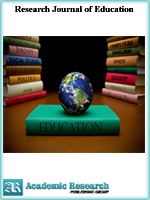Research Journal of Education
Online ISSN: 2413-0540
Print ISSN: 2413-8886
Print ISSN: 2413-8886
Quarterly Published (4 Issues Per Year)

Archives
Volume 7 Number 3 September 2021
Activity-Based Teaching and Learning Approach and Students’ Academic Performance: Evidence from Among Stakeholders from Barekese District Ashanti Region of Ghana
Authors: Theophilus Apenuvor ; Frank Yao Gbadago ; Kwadwo Ankomah ; Agnes Fafa Anthony
Pages: 156-160
DOI: doi.org/10.32861/rje.73.156.160
Abstract
In this study, the authors explored the level of awareness and views on the activity-based approach to teaching and learning (ABTLA) in enhancing skills, competency, and academic performance among students and other stakeholders from Senior High Schools (SHS) and Colleges of Education (COE) in Barekese District of Ashanti Region of Ghana. A survey involving 510 various stakeholders was conducted within the Barekese District of Ashanti Region of Ghana, using sets of a self-administered structured questionnaire. The study revealed that the Ghanaian stakeholders of the second cycle and COEs are highly aware of ABTLA and its potency for enhancing skills, competency, and academic performance among students. Policy implications and further future research directions were provided.
Assessing Teachers’ Self-Efficacy Beliefs Using Bandura’s Scale
Authors: Vilma Muega- Geronimo
Pages: 150-155
DOI: doi.org/10.32861/rje.73.150.155
Abstract
The study aimed to assess the level of teacher’s self-efficacy belief as input to faculty development plan based on Bandura’s instrument. Mean and ranking were utilized to determine the Teachers’ Self- efficacy level. The results show that faculty members have higher efficacy in terms of discipline, instruction, create a positive school climate. Meanwhile, low efficacy in terms of influence in school resources, enlist parental and community involvement, and influencing decision making in the University. Generally, it indicates that faculty members need to enhance their self-efficacy belief in some aspects. It is suggested to include a plan as part of the faculty development program to enhance the teachers’ self-efficacy level particularly on decision making, community involvement, getting school resources, and parental involvement.
The Kids are Alright: Middle-Level Students’ Perceptions of School During COVID-19
Authors: C. Anne Gutshall ; Joshua D. McCall
Pages: 141-149
DOI: doi.org/10.32861/rje.73.141.149
Abstract
This research sought to determine middle school students’ perceptions of the academic year they experienced during the COVID-19 pandemic in a district in South Carolina. The students were surveyed three times throughout the year (beginning, midyear, and end of year), and their responses were disaggregated by the instructional model choice (face-to-face, in-person instruction, and online, virtual instruction via webcam technology). Families of students in this district were offered a choice of these two instructional models throughout the year, and the reasons for their family’s choice were surveyed. Students who were face-to-face for the entire year were more likely to perceive their school year as a positive experience than their online peers, but both groups identified that despite the circumstances, they mostly felt positive about the year, except in the case of being able to make friends, in which face-to-face students’ responses were significantly more positive. Also, students reported spending time during the previous school year’s shutdown (March 2020 to the end of the school year in June) completing many different academics and social tasks in which they were able to develop skills and direct their free time. The results of this research suggest that consistent with previous research suggesting that offering a few options results in people feeling satisfied, this research suggests that in the future when faced with difficult choices at the district level on how to handle student experiences in unprecedented circumstances, offering choice to the students and families may benefit the outcomes of those students and the district overall.
Quantitative Analysis of Eye Movements during Singing of Early Childhood Children
Authors: Mina Sano
Pages: 125-140
DOI: doi.org/10.32861/rje.73.125.140
Abstract
Early childhood children tend to make musical expressions watching other children or the teacher’s piano accompaniment. However, it has not been inspected yet how eye movement is affected by music. To provide the optimized procedure to capture eye movement’s characteristics reflecting music, the statistical technique was used to evaluate effective parameters. In this study, eye trackers (Tobii Glasses 2) were used to acquire data of eye movements during musical expression of early childhood children and to conduct quantitative analysis. 3-year-old, 4-year-old, and 5-year-old children in two early childhood facilities (n=58) participated in eye-tracking while singing multiple songs of major and minor. This paper focuses on saccade (rapid eye movement) and gaze behaviors of early childhood children and mainly conducts, a three-way analysis of variance (ANOVA) on the acquired data (age * facility*tonality). As a result, it was found that the number of occurrences of saccade and the total moving distances of saccade showed a statistical significance between means regarding differences in the tonality of major/minor key of songs, and childcare forms.



